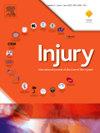南非中部某三级医院骨科中心因性别暴力造成的肌肉骨骼损伤
IF 2.2
3区 医学
Q3 CRITICAL CARE MEDICINE
Injury-International Journal of the Care of the Injured
Pub Date : 2024-11-22
DOI:10.1016/j.injury.2024.112061
引用次数: 0
摘要
南非进行了一项有限的研究,描述了基于性别的暴力(GBV)受害者的骨科肌肉骨骼损伤模式。由于我们当地性别暴力的高发,卫生保健工作者有必要确定这一弱势群体,以便进行早期管理、干预和预防随后的袭击。本研究旨在描述由GBV引起的身体攻击导致的肌肉骨骼损伤模式。方法回顾性分析南非某三级医院骨科的临床资料。分析了2021年1月1日至2021年12月31日期间性别暴力受害者的医疗记录,包括患有急性肌肉骨骼损伤的成年男性和女性。结果138例GBV受害者中,92.7%为女性,中位年龄32岁(19-80岁)。大多数(66.7%)是失业者,而63.8%的病例发生在亲密伴侣关系中。主要损伤机制为钝器伤(35.5%)、刺伤伤(22.4%)和站立坠落伤(19.5%)。男性主要是软组织损伤(60.0%),而女性主要是上肢骨折(53.9%)。34.1%的受害者有软组织损伤,其中23.3%为撕裂伤。超过一半(51.5%)的受害者上肢骨折,19.6%的受害者下肢骨折。性别与上肢骨折发生率有显著差异(p = 0.0328)。上肢骨折以孤立尺骨骨折为主(18.8%)。16:00 - 00:00期间,雄鼠(70.0%)和雌鼠(60.9%)以受伤为主;50.7%的性侵发生在周末。总体而言,47.1%的人报告饮酒,这与女性性别密切相关,因为48.4%的女性报告自己或攻击者饮酒,而男性受害者的这一比例为30.0% (p = 0.026)。结论在我们的研究中,肌肉骨骼损伤的模式可能是由于攻击的防御动作,特别是在女性受害者中。酒精使用与性别暴力之间的关联使这种情况更加恶化,因此,强调了确定和保护这一弱势群体的干预措施的重要性。本文章由计算机程序翻译,如有差异,请以英文原文为准。
Musculoskeletal injuries from gender-based violence at a tertiary hospital orthopaedic centre, central South Africa
Introduction
Limited research describing the pattern of orthopaedic musculoskeletal injuries among gender-based violence (GBV) victims has been conducted in South Africa. With the high prevalence of GBV in our locality, there is a need for healthcare workers to identify this vulnerable population for early management, intervention, and prevention of subsequent assaults. This study aimed to describe the pattern of musculoskeletal injuries resulting from physical assaults due to GBV.
Methods
This retrospective analysis was conducted in the orthopaedic department of a tertiary hospital in South Africa. Medical records of GBV victims between 01 January 2021 and 31 December 2021, including adult males and females with acute musculoskeletal injuries, were analysed.
Results
Of the 138 GBV victims, 92.7 % were female, with a median age of 32 (range 19–80). Most (66.7 %) were unemployed, while 63.8 % of cases occurred within intimate partner relationships. The predominant mechanism of injury was blunt force trauma (35.5 %), stab injuries (22.4 %), and fall from standing height (19.5 %). Men predominantly sustained soft tissue injuries (60.0 %), while women sustained upper limb fractures (53.9 %). Soft tissue injuries were noted in 34.1 % of victims, of which 23.3 % were lacerations. Just over half (51.5 %) of victims had upper limb fractures, and 19.6 % had lower limb fractures. A significant difference was found between gender and upper limb fractures (p = 0.0328). Isolated ulnar fracture was the predominant upper limb fracture (18.8 %). Males (70.0 %) and females (60.9 %) were predominantly injured between 16:00 and 00:00; 50.7 % of assaults occurred over weekends. Overall, 47.1 % reported alcohol use, which was strongly associated with female gender as 48.4 % of females reported its use either by themselves or their assailant, compared to 30.0 % of male victims (p = 0.026).
Conclusion
The pattern of musculoskeletal injuries in our study may be due to defensive manoeuvres from assaults, especially among female victims. This is worsened by the association between alcohol use and GBV and, therefore, underlines the importance of interventions to identify and protect this vulnerable population.
求助全文
通过发布文献求助,成功后即可免费获取论文全文。
去求助
来源期刊
CiteScore
4.00
自引率
8.00%
发文量
699
审稿时长
96 days
期刊介绍:
Injury was founded in 1969 and is an international journal dealing with all aspects of trauma care and accident surgery. Our primary aim is to facilitate the exchange of ideas, techniques and information among all members of the trauma team.

 求助内容:
求助内容: 应助结果提醒方式:
应助结果提醒方式:


